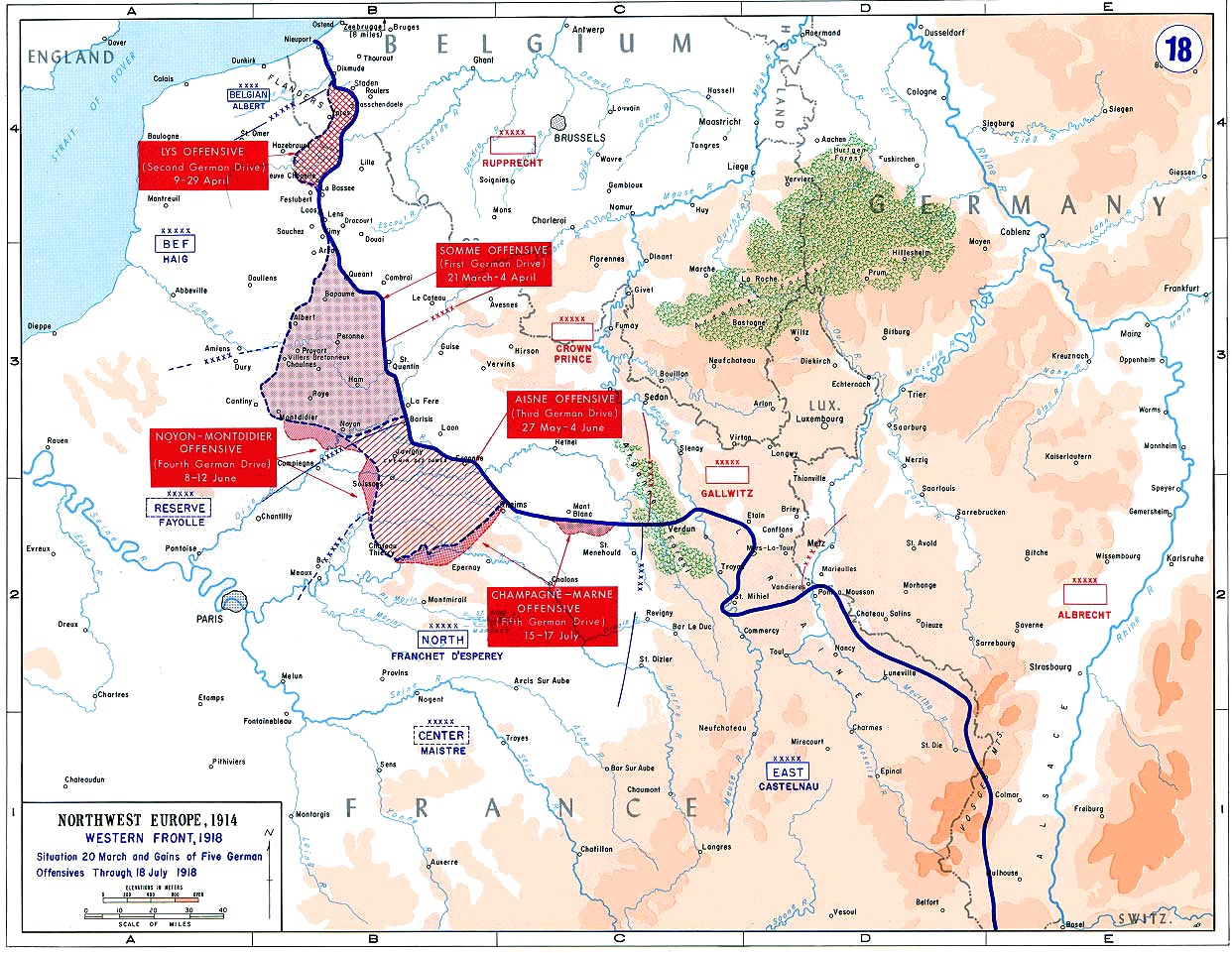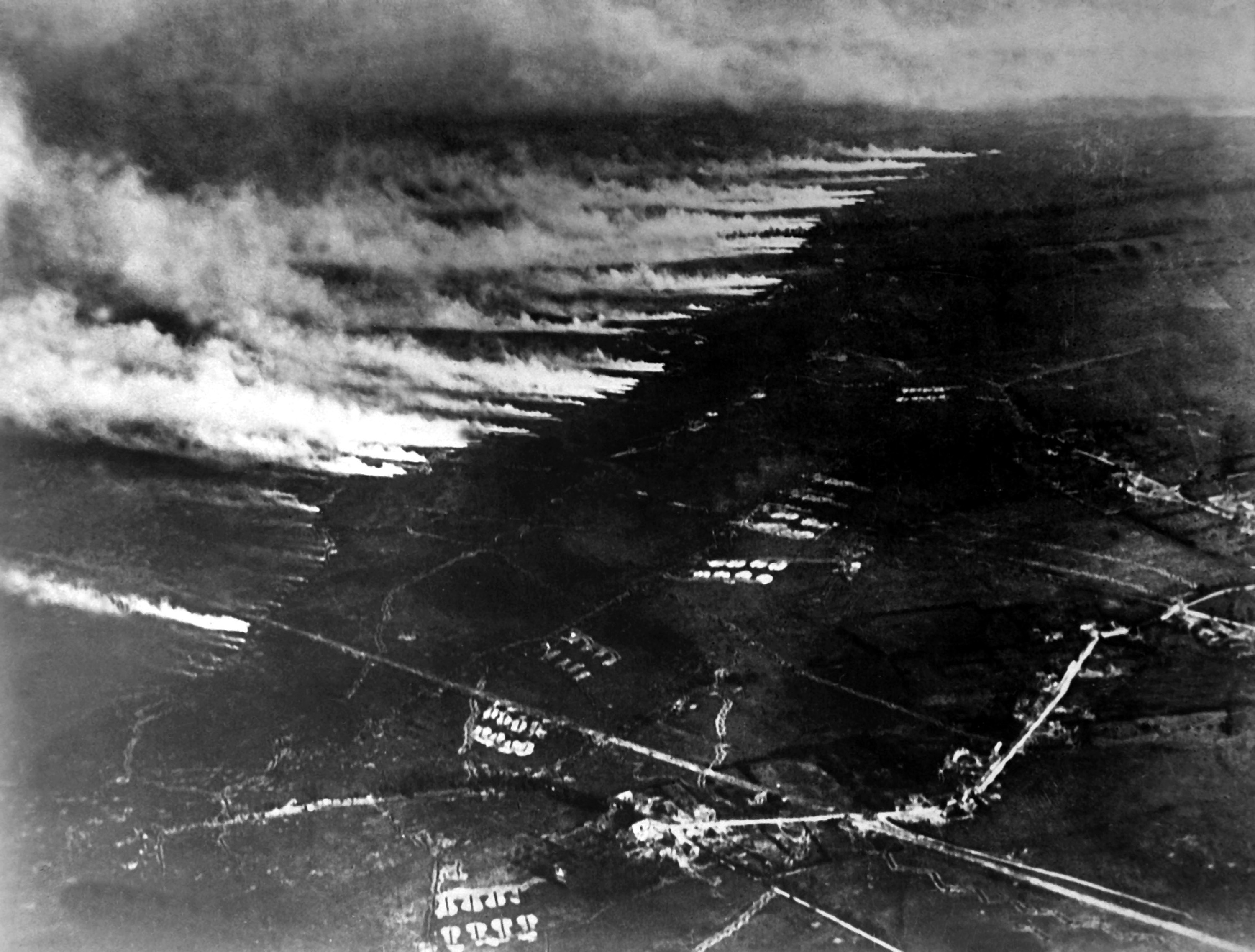|
Battle Of Avre
The Battle of the Avre (4–5 April 1918), part of the First Battle of Villers-Bretonneux, constituted the final German attack towards Amiens in World War I. It was the point at which the Germans got the closest to Amiens. It was fought between attacking German troops and defending Australian and British troops. The attack was an attempt to take Amiens, where other aspects of Operation Michael had failed. The Avre marked the beginning of the end for Ludendorf's German spring offensive. Prelude Preliminary moves (29–30 March) across the southern battlefields by German 2nd Army proved so slow and difficult that offensive operations were suspended between 1–3 April to allow German forces to recover. Battle 4 April The final German attack was eventually launched towards Amiens. It came on 4 April, when fifteen divisions attacked seven Allied divisions on a line east of Amiens and north of Albert (towards the Avre River). Ludendorff decided to attack the outermost easte ... [...More Info...] [...Related Items...] OR: [Wikipedia] [Google] [Baidu] |
Operation Michael
Operation Michael was a major German military offensive during the First World War that began the German Spring Offensive on 21 March 1918. It was launched from the Hindenburg Line, in the vicinity of Saint-Quentin, France. Its goal was to break through the Allied (Entente) lines and advance in a north-westerly direction to seize the Channel Ports, which supplied the British Expeditionary Force (BEF) and to drive the BEF into the sea. Two days later General Erich Ludendorff, the chief of the German General Staff, adjusted his plan and pushed for an offensive due west, along the whole of the British front north of the River Somme. This was designed to first separate the French and British Armies before continuing with the original concept of pushing the BEF into the sea. The offensive ended at Villers-Bretonneux, to the east of the Allied communications centre at Amiens, where the Allies managed to halt the German advance; the German Army had suffered many casualties and was ... [...More Info...] [...Related Items...] OR: [Wikipedia] [Google] [Baidu] |
39th (Deptford) Divisional Artillery
Rrr The 39th (Deptford) Divisional Artillery (39th DA) was a Royal Artillery force raised as part of ' Kitchener's Army' in early 1915. Recruited in Deptford, South London, the units served with the 'Pals battalions' of the 39th Division on the Western Front for two years. They saw action at the Somme, Ypres, and the German spring offensive, including the Battle of the Avre, described as 'one of the finest artillery stories of the whole war'. The units then operated as an independent artillery formation during the Allied Hundred Days Offensive. Background On 6 August 1914, less than 48 hours after Britain's declaration of war, Parliament sanctioned an increase of 500,000 men for the Regular British Army, and the newly appointed Secretary of State for War, Earl Kitchener of Khartoum issued his famous call to arms: 'Your King and Country Need You', urging the first 100,000 volunteers to come forward. This group of six divisions with supporting arms became known as Kitchener's F ... [...More Info...] [...Related Items...] OR: [Wikipedia] [Google] [Baidu] |
Open Sights
Iron sights are a system of physical alignment markers (usually made of metallic material) used as a sighting device to assist the accurate aiming of ranged weapons (such as a firearm, airgun, crossbow or even compound bow), or less commonly as a primitive finder sight for optical telescopes. The earliest sighting device, it relies completely on the viewer's naked eye (mostly under ambient lighting), and is distinctly different to optical sights such as telescopic sights, reflector (reflex) sights, holographic sights and laser sights, which make use of optical manipulation and/or active illumination, as well as the newer optoelectronics, which use digital imaging and even incorporate augmented reality. Iron sights are typically composed of two components mounted perpendicularly above the weapon's bore axis: a rear sight nearer (or ''proximally'') to the shooter's eye, and a front sight farther forward (or ''distally'') near the muzzle. During aiming, the shooter aligns his/ ... [...More Info...] [...Related Items...] OR: [Wikipedia] [Google] [Baidu] |
Le Hamel, Somme
Le Hamel () is a commune in the Somme department and Hauts-de-France region of northern France. Geography Le Hamel is situated some 20 km east of Amiens in the valley of the Somme. The surrounding district is the historical Santerre, a lightly wooded and agricultural plateau. History The settlement is first documented in 1184 as belonging to the powerful abbey of Corbie. The name has the same root as ''hameau'' ("hamlet"), a small rural settlement. The town and surrounding countryside was the scene of the Battle of Hamel on 4 July 1918, during World War I. The battle, despite being small in scale, is notable for being the first instance in which combined arms tactics were used in warfare. Places of interest * A park commemorating the 1000+ Australian troops who died in the Battle of Hamel was inaugurated on 4 July 1998, exactly 80 years after the date of the event. The site symbolises the friendship between France and Australia. * The lakes of the Somme valley. Image: ... [...More Info...] [...Related Items...] OR: [Wikipedia] [Google] [Baidu] |
Le Hamel (Somme) Clocher De L Eglise
Le Hamel is the name of the following communes in France: * Le Hamel, Oise, in the Oise department * Le Hamel, Somme, in the Somme department * Le Hamel, a hamlet of the commune of Asnelles Asnelles () is a commune in the Calvados department in the Normandy region of north-western France. The inhabitants of the commune are known as ''Asnellois'' or ''Asnelloises''. Geography Asnelles is located at the seaside some 13 km nort ..., Calvados See also * Hamel (other) {{geodis ... [...More Info...] [...Related Items...] OR: [Wikipedia] [Google] [Baidu] |
Shrapnel Shell
Shrapnel shells were anti-personnel artillery munitions which carried many individual bullets close to a target area and then ejected them to allow them to continue along the shell's trajectory and strike targets individually. They relied almost entirely on the shell's velocity for their lethality. The munition has been obsolete since the end of World War I for anti-personnel use; high-explosive shells superseded it for that role. The functioning and principles behind Shrapnel shells are fundamentally different from high-explosive shell fragmentation. Shrapnel is named after Lieutenant-General Henry Shrapnel (1761–1842), a British artillery officer, whose experiments, initially conducted on his own time and at his own expense, culminated in the design and development of a new type of artillery shell. Usage of term "shrapnel" has changed over time to also refer to fragmentation of the casing of shells and bombs. This is its most common modern usage, which strays from the o ... [...More Info...] [...Related Items...] OR: [Wikipedia] [Google] [Baidu] |
Enfilade And Defilade
Enfilade and defilade are concepts in military tactics used to describe a military formation's exposure to enemy fire. A formation or position is "in enfilade" if weapon fire can be directed along its longest axis. A unit or position is "in defilade" if it uses natural or artificial obstacles to shield or conceal itself from enfilade and hostile fire. The strategies, named by the English during the Hundred Years' War, use the French '' enfiler'' ("to put on a string or sling") and ''défiler'' ("to slip away or off") spoken by English nobility of the time. Enfilade fire—gunfire directed against an enfiladed formation or position—is also commonly known as "flanking fire". Raking fire is the equivalent term in naval warfare. Strafing, firing on targets from a flying platform, is often done with enfilade fire. It is a very advantageous, and much sought for, position for the attacking force. Enfilade A formation or position is "in enfilade" if weapon fire can be dire ... [...More Info...] [...Related Items...] OR: [Wikipedia] [Google] [Baidu] |
Chemical Weapons In World War I
The use of toxic chemicals as weapons dates back thousands of years, but the first large scale use of chemical weapons was during World War I. They were primarily used to demoralize, injure, and kill entrenched defenders, against whom the indiscriminate and generally very slow-moving or static nature of gas clouds would be most effective. The types of weapons employed ranged from disabling chemicals, such as tear gas, to lethal agents like phosgene, chlorine, and mustard gas. This chemical warfare was a major component of the first global war and first total war of the 20th century. The killing capacity of gas was limited, with about 90,000 fatalities from a total of 1.3 million casualties caused by gas attacks. Gas was unlike most other weapons of the period because it was possible to develop countermeasures, such as gas masks. In the later stages of the war, as the use of gas increased, its overall effectiveness diminished. The widespread use of these agents of chemical warfar ... [...More Info...] [...Related Items...] OR: [Wikipedia] [Google] [Baidu] |
The German Spring Offensive, March-july 1918 Q8655
''The'' () is a grammatical article in English, denoting persons or things already mentioned, under discussion, implied or otherwise presumed familiar to listeners, readers, or speakers. It is the definite article in English. ''The'' is the most frequently used word in the English language; studies and analyses of texts have found it to account for seven percent of all printed English-language words. It is derived from gendered articles in Old English which combined in Middle English and now has a single form used with pronouns of any gender. The word can be used with both singular and plural nouns, and with a noun that starts with any letter. This is different from many other languages, which have different forms of the definite article for different genders or numbers. Pronunciation In most dialects, "the" is pronounced as (with the voiced dental fricative followed by a schwa) when followed by a consonant sound, and as (homophone of pronoun ''thee'') when followed by a ... [...More Info...] [...Related Items...] OR: [Wikipedia] [Google] [Baidu] |
QF 4
QF may stand for: * Qantas, an airline of Australia (IATA code QF) * Qatar Foundation, a private, chartered, non-profit organization in the state of Qatar * Quality factor, in physics and engineering, a measure of the "quality" of a resonant system * Quick-firing gun, a sort of artillery piece * Quiverfull, a movement of Christians who eschew all forms of birth control * A gun breech that uses metallic cartridges (see British ordnance terms#QF) * Quds Force The Quds Force ( fa, نیروی قدس, niru-ye qods, Jerusalem Force) is one of five branches of Iran's Islamic Revolutionary Guard Corps (IRGC) specializing in unconventional warfare and military intelligence operations. U.S. Army's Iraq War ... an expeditionary warfare unit of IRGC {{disambig fr:QF ... [...More Info...] [...Related Items...] OR: [Wikipedia] [Google] [Baidu] |
Ordnance QF 18-pounder
The Ordnance QF 18-pounder,British military traditionally denoted smaller ordnance by the weight of its standard projectile, in this case approximately or simply 18-pounder gun, was the standard British Empire field gun of the World War I, First World War-era. It formed the backbone of the Royal Field Artillery during the war, and was produced in large numbers. It was used by British Forces in all the main theatres, and by British troops in Russia in 1919. Its calibre (84 mm) and shell weight were greater than those of the equivalent field guns in French (75 mm) and German (77 mm) service. It was generally horse drawn until mechanisation in the 1930s. The first versions were introduced in 1904. Later versions remained in service with British forces until early 1942. During the interwar period, the 18-pounder was developed into the early versions of the equally famous Ordnance QF 25-pounder, which would form the basis of the British artillery forces during and af ... [...More Info...] [...Related Items...] OR: [Wikipedia] [Google] [Baidu] |





.png)
